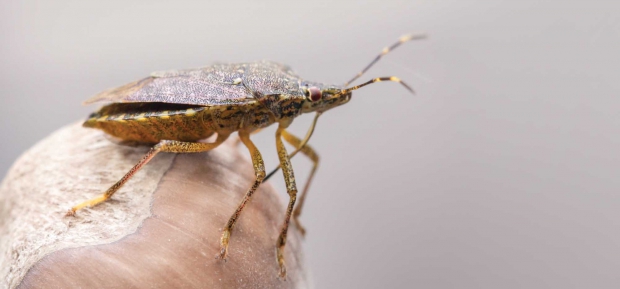
Brown marmorated stink bug (BMSB). (Courtesy Chris Hedstrom)
Mid-Atlantic area fruit and vegetable growers who have the full range of control options at their disposal are having trouble containing the brown marmorated stinkbug. So imagine how hard it must be for organic growers, with their limited arsenal of insecticides.
There are very few organic fruit growers in the challenging climate of the eastern United States, but some researchers there hold out hope that they can someday manage it.
Organic management of BMSB was one of the “current issues in organic fruit production” that were addressed during the Great Lakes Fruit, Vegetable, and Farm Market Expo in Michigan.
Dr. Anne Nielsen, one of the first to study BMSB when it was found in the East, said organic growers would have to rely on integrating multiple methods such as natural enemies, cultural management, and/or habitat manipulation for control.
Nielsen was a graduate student at Rutgers University in New Jersey when the stinkbug was first found. She did postdoctorate work at Michigan State University and is now back at Rutgers, still working with the stinky insect that smells, she says, like a combination of cilantro and dirty socks.
Trap crops
The stinkbug has some behavioral traits that can be used against it, she said.
One is that it is attracted by an aggregation pheromone and also by some plants more than others. This has led her to study trap crops and trap trees.
“If we can find a really attractive host plant that would lure them, we could stop them at the edge of orchards and other crops,” she said.
In four mid-Atlantic states in 2013, trap crops of millet, sunflowers, sorghum, and okra were tested. “They came!” she said about the bugs. “Sorghum was the clear winner but sunflowers worked, too.”
Researchers in 2014 then tested the concept of using sorghum and sunflower trap crops planted around the perimeter of sweet pepper plantings.
“We can attract them. Now what we need is to add an insecticide that could be sprayed while they are there,” she said. Conventional growers will find that less difficult than organic growers.
She found the trap crops attractive enough that they even pulled some bugs back out of the peppers. Combining a trap crop with a pheromone may be even more effective, she said.
In related research, Nielsen and her lab colleagues have noticed a strong edge effect and found that orchards endure less damage on the interior because most of the stinkbugs don’t penetrate deep into orchard blocks.
They move into orchards from outside, and go just far enough to find the fruit they want to feed on. Treating the orchard border with insecticide prevented BMSB from moving to the interior and resulted in the same injury to fruit but with significantly less insecticide than when spraying the whole orchard.
Similar trials have evaluated using kaolin clay (Surround) to repel the stinkbugs, but that tended to drive them out of sprayed trees and deeper into the orchard block, she said.
There is some evidence as well that native predators are developing a taste for this Asian invader species. Last year, individual BMSB egg masses were videotaped to see what came to eat them.
“Katydids consumed entire egg masses,” Nielsen said, and generalist predators had, she estimated, a 5 to 10 percent impact on the BMSB population. •
More online:
Dr. Anne Nielsen and About 50 researchers from multiple institutions across the country are using Specialty Crop Research Initiative and Organic Research and Education Initiative funding to study the stinkbug. They have informative websites at www.stopbmsb.org and at http://bit.ly/1zAtKbb.






They are also attracted to light. Clip a reflector lamp to the top of a half-filled (with water) 5-gallon pail. They head toward the light, or its reflection, and drown.
Just wondering if diatomaceous earth around an attracting plant base would do the tricK? They don’t seem to mind crawling around in it and it does a magnificent job of reducing the population on melons.